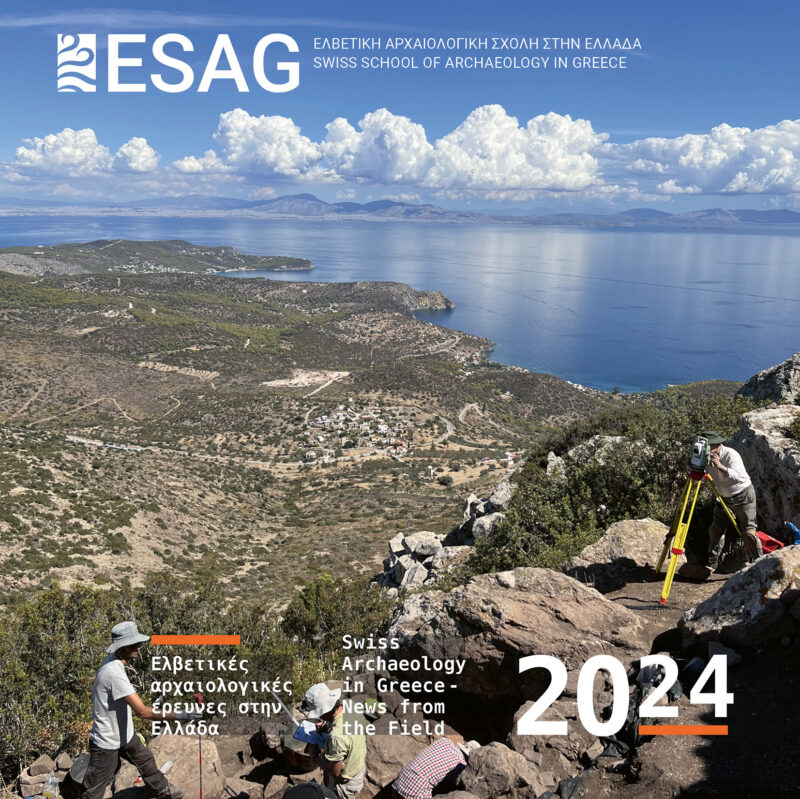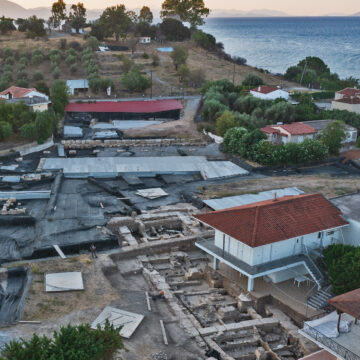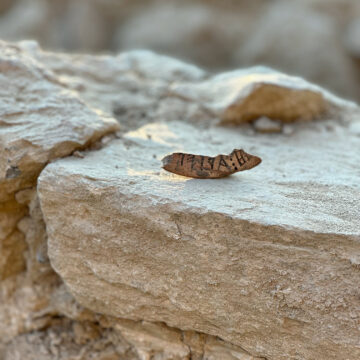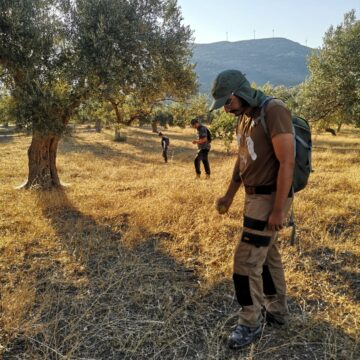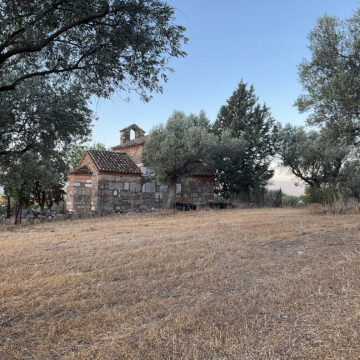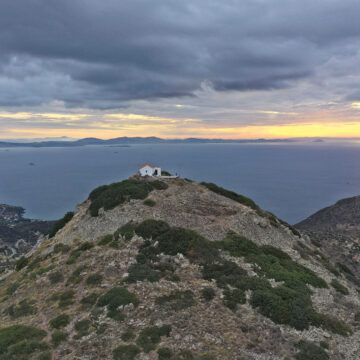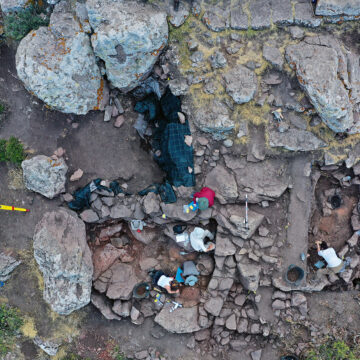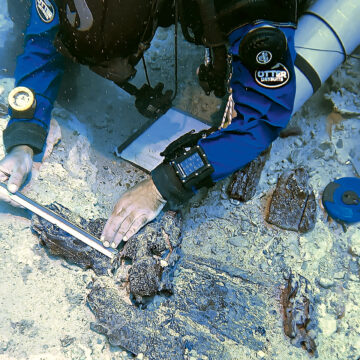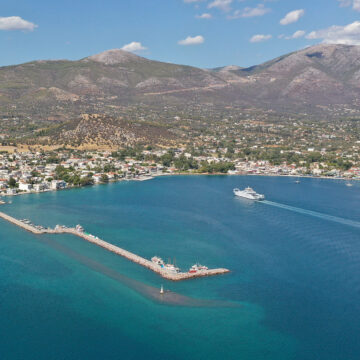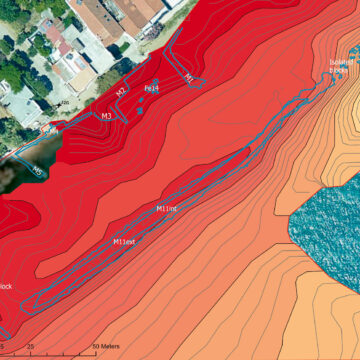Swiss Archaeology in Greece – News from the Field 2024
Director’s foreword
Under the blazing July sun, the final actions of pickaxes and trowels signal the temporary cessation of excavations at the Artemision of Amarynthos after a stretch of thirteen consecutive seasons (2012–2024). The excavators go back to the museums and libraries, trading their field instruments for scalpels, cotton swabs, and computer keyboards. Archaeology’s shadow work begins: the analysis and publication of discoveries. Each day dedicated to excavation demands at least 20 days of study. Do the math, archaeology is a lengthy process… It also requires constant monitoring and financial support to restore, exploit, and present every investigation element. The temple sector alone requires the collaboration of dozens of researchers from around the world. Over the years, the ESAG has diligently developed a reliable framework that should facilitate publication. The first volume of the new AMARYNTHOS series will be released at the end of 2024. The distinction is rightfully awarded to Denis Knoepfler, who publishes an important decree found in the Sanctuary and delivers a masterly account of the complex history of Euboea at the turn of the 4th century BC.
Despite the recent focus on Amarynthos, ongoing studies have remained active at Eretria. A summary highlighting three researchers’ portraits can be found at the end of this publication. Other studies are in progress, in particular on Prehistoric (Sylvie Müller), Classical (Claudia Gamma) and Roman (Simone Zurbriggen) pottery. We eagerly await in 2024 the release of Tamara Saggini’s monograph, featured in volume XXVI of the ERETRIA series, that explores the Archaic pottery from Eretria and sheds new light on a key chapter in the history of the city when it was taken over by the Persian army.
At the same time, the School’s training and research mission continues. This year, several internships enabled Swiss students to perfect their skills in pottery, small finds, and architecture. The ESAG oversaw several projects in the field, both in Euboea and in other Aegean locations: the Eretria-Amarynthos Survey Project continued its work, and excavations on Mount Hellanion Oros in Aegina once again revealed compelling information regarding the island’s settlement from the Bronze Age to the Early Iron Age. At Antikythera, underwater excavations continue to bring elements of the famous shipwreck and its cargo to the surface. The year 2024 also marks the return of on-site research at Eretria, as a three-year project begins to investigate and document the ancient harbor. Thanks to the collaboration with the Ephorate of Underwater Antiquities and the Octopus Foundation, divers cleaned and recorded portions of the harbor’s facilities and the fortifications that protected them.
Archaeological research is advancing in laboratory contexts as well as in the field. The Eretria ancient DNA project, conducted in collaboration with the University of Lausanne’s Department of Computational Biology, has produced noteworthy early results concerning the identities of ancient Eretrian populations from the Bronze Age to the Late Roman period.
1964–2024
The year 2024 marks the sixtieth anniversary of the start of Swiss excavations at Eretria. It is an opportunity to recall the visionary and pioneering role played by our predecessors, Karl Schefold and Lily Kahil on the Swiss side, and Ioannis Papadimitriou and Vasilis Petrakos on the Greek side. Without their joint efforts, Swiss archaeology in Greece would not be what it is today.
In terms of anniversaries, 2025 will mark the 50th anniversary of the Swiss School of Archaeology in Greece, the only permanent Swiss archaeological mission outside the country’s borders, without which, it should be remembered, it would be impossible to carry out ambitious Swiss excavations and research in Greece.
Artemision at Amarynthos (Euboea), excavations and survey
The 2024 summer excavation in the Artemision was the last campaign in the area of the temples before research enters a new phase, focusing on the study and publication of the finds. An important discovery this year was the rounded porch of the late 8th c. BC temple. Two older buildings of the Mycenaean period were uncovered beneath the temple’s foundations. At the same time, the natural ground level was reached at the hill of Paleoekklisies after the excavation of 3m. of sediments, and yielded a large quantity of pottery of the Early Helladic I period, around 3000 BC.
The Eretria-Amarynthos Survey Project investigates the development of human occupation in the plain of Eretria from the Bronze Age to the Byzantine period. Particular attention is paid to the sanctuary of Artemis and its influence on the spatial organization of the region. As part of the fourth campaign, the banks of the Sarandapotamos river were investigated in order to ensure continuity with the previous investigations. Despite the few archaeological finds located in the delta, significant concentrations were identified in higher areas. Remains from the Late Byzantine and more ancient periods were found in Gymnou, indicating a significant settlement in the area.
Artemision Project - AmarynthosFieldwork on Mount Hellanion Oros, Aegina
The five-year programme at Hellanion Oros on the island of Aegina features two main research axes: the excavation on the summit and the archaeological survey of the surrounding area at the southern tip of the island. During this fourth campaign, the work of the Greek-Swiss team focused on uncovering the remains of the fortified settlement of the Mycenaean period. Two buildings yielded numerous storage and cooking vessels, as well as a tomb. Furthermore, the surface survey revealed two new sites, one dating to the end of the 4th – beginning of the 3rd millennium BC, and one occupied in the Mycenaean period and in the 1st millennium BC, as well as a quarry.
Underwater fieldwork at Antikythera
Ιn May/June 2024, a team of Swiss and Greek archaeologists and divers completed the fourth underwater research campaign on the Antikythera shipwreck. The work is part of a five-year research programme (2021–2025) of the Swiss School of Archaeology in Greece, led by the University of Geneva. The systematic underwater excavations, which once again used state-of-the-art technologies such as underwater drones and photogrammetry, in addition to the installation of a scientific field laboratory on site, led, among others, to the discovery of part of the ship’s hull at «Site A». Initial investigations of «Site B» have also yielded evidence of the remains of a shipwreck. The relationship between the two sites, no more than 200 m. apart, remains to be clarified.
Antikythera projectEretria Harbour Project
A project aimed at studying and mapping the underwater features of Eretrias ancient harbor was started in 2024. Numerous sections of the ancient walls and key breakwaters, lying at depths of 1.5 to 3 meters, were systematically cleaned and accurately mapped, leading to the acquisition of new data about the topography of the ancient city, the bathymetry, as well as the sea-level changes since Antiquity.
Eretria Harbour Project
Sylvian Fachard, director of the ESAG
There is not enough space here to thank all the institutions and individuals who have supported the activities of the School. Special mention should be made of the Hellenic Ministry of Culture, the Swiss Confederation (SERI), the Swiss National Science Foundation, the University of Lausanne Foundation, the Canton of Vaud, the Evangelos Pistiolis Foundation, the Stavros Niarchos Foundation, the KIKPE Foundation and the Sandoz Family Philanthropic Foundation. We are also very grateful to our Greek partners for their fruitful collaboration in the field and in the museum, in particular Angeliki G. Simosi, Stella Chryssoulaki and Eleni Sp. Banou.
Acknowledgements
Hellenic Ministry of Culture, Lina Mendoni
Directorate of Antiquities in the Greek –Ministry of Culture, Olympia Vikatou (Director General)
–Department of Foreign Schools, Konstantina Benisi (Head), Sophia Spyropoulou
–Ephorate of Antiquities of Euboea, Dimitrios Christodoulou (Head), Olga Kyriazi, Fani Stavroulaki, Stavroula Parissi
–Ephorate of Antiquities of Piraeus and Islands, Andreas Darlas (Head)
–Embassy of Switzerland in Greece, HE Stefan Estermann
–Embassy of Greece in Switzerland, HE Ekaterini Simopoulou
–Municipality of Eretria, Nikos Gournis
–Prefecture of Central Greece, regional district of Euboea, Giorgos Kelaiditis
–Cultural Association of Amarynthos, Leonardos Bilalis
–Gerani Association, Kostas Fragoulopoulos
–University of Lausanne, rectorate, deanship of the Faculty of Arts, Juanita Béguin, Dominique Thierrin, Antonio Santangel, Dilek Güngör, Coralie Grossrieder, Patrizia Ponti, Antoinette Nadal
Donors and patrons
–Swiss National Science Foundation
–Federal Department of Economic Affairs, Education and Research
–State Secretariat for Education, Research and Innovation
–Public utility fund of the Canton of Vaud
–University of Lausanne and other Universities in Switzerland
–S. Niarchos Foundation, KIKPE Foundation, Sandoz Family Charitable Foundation, Evangelos Pistiolis Foundation, Isaac Dreyfus-Bernheim Foundation, Theodoros Lagoniko Foundation, Afendouli Foundation, Ceramica-Stiftung, Vaudoise Academic Society, Pittet Foundation
